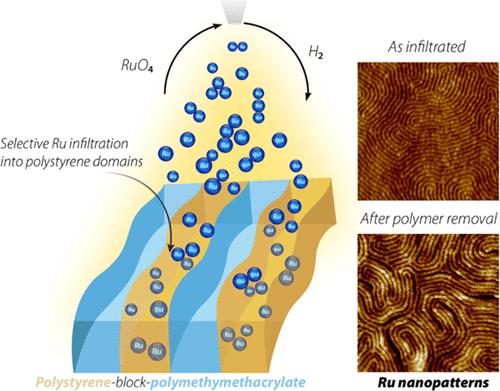当前位置:
X-MOL 学术
›
Chem. Mater.
›
论文详情
Our official English website, www.x-mol.net, welcomes your feedback! (Note: you will need to create a separate account there.)
Spatially Templated Nanolines of Ru and RuO2 by Sequential Infiltration Synthesis
Chemistry of Materials ( IF 8.6 ) Pub Date : 2022-11-14 , DOI: 10.1021/acs.chemmater.2c01866 Nithin Poonkottil 1 , Eduardo Solano 2 , Arbresha Muriqi 3 , Matthias M. Minjauw 1 , Matthias Filez 1 , Michael Nolan 3 , Christophe Detavernier 1 , Jolien Dendooven 1
Chemistry of Materials ( IF 8.6 ) Pub Date : 2022-11-14 , DOI: 10.1021/acs.chemmater.2c01866 Nithin Poonkottil 1 , Eduardo Solano 2 , Arbresha Muriqi 3 , Matthias M. Minjauw 1 , Matthias Filez 1 , Michael Nolan 3 , Christophe Detavernier 1 , Jolien Dendooven 1
Affiliation

|
Nanoscale patterning of inorganics is crucial for the fabrication of advanced electronic, photonic, and energy devices. The emerging sequential infiltration synthesis (SIS) method fabricates nanofeatures by block-selective vapor-phase growth in block copolymer templates with tunable patterns. Yet, SIS has been demonstrated mainly for Al2O3 and a few other metal oxides, while deriving metal nanostructures from a single SIS process is a challenge. Here, we present SIS of the Ru metal in polystyrene-block-polymethyl methacrylate (PS-b-PMMA) templates without any pretreatment, using alternating infiltration of RuO4 and H2. RuO4 interacts selectively and strongly with the aromatic C═C and C–H groups in PS, leaving the PMMA domains inert. Density functional theory calculations corroborate that the PS–RuO4 interaction is energetically favorable, with a calculated interaction energy of −1.65 eV, whereas for PMMA–RuO4, the calculated energy of −0.05 eV indicates an unfavorable interaction. Morphological analysis on the di-BCP after the RuO4-H2 process indicates an increase in contrast as a function of SIS cycles and templated Ru incorporation. The crystalline nature of the Ru deposits is confirmed using grazing incidence wide-angle X-ray scattering. Plasma-aided removal of the organic components yields Ru nanolines with lateral dimensions of ca 20 nm. We further highlight the broad potential of RuO4 as a reactant for SIS by generating RuO2 nanopatterns via alternating RuO4 and methanol infiltration.
中文翻译:

通过顺序渗透合成 Ru 和 RuO2 的空间模板化纳米线
无机物的纳米级图案化对于制造先进的电子、光子和能源设备至关重要。新兴的顺序渗透合成 (SIS) 方法通过嵌段选择性气相生长在具有可调模式的嵌段共聚物模板中制造纳米特征。然而,SIS 主要针对 Al 2 O 3和一些其他金属氧化物进行了论证,而从单一 SIS 工艺中获得金属纳米结构是一项挑战。在这里,我们展示了 Ru 金属在聚苯乙烯-嵌段-聚甲基丙烯酸甲酯 (PS-b-PMMA) 模板中的 SIS,无需任何预处理,使用 RuO 4 和H 2的交替渗透。RuO 4与 PS 中的芳香族 C=C 和 C-H 基团选择性且强烈地相互作用,使 PMMA 域保持惰性。密度泛函理论计算证实 PS-RuO 4相互作用在能量上是有利的,计算的相互作用能为-1.65 eV,而对于 PMMA-RuO 4,计算的能量为-0.05 eV 表明相互作用不利。RuO 4 -H 2后di-BCP的形貌分析过程表明对比度随着 SIS 循环和模板化 Ru 掺入而增加。使用掠入射广角 X 射线散射确认 Ru 沉积物的结晶性质。等离子辅助去除有机成分产生横向尺寸为 ca 20 nm 的 Ru 纳米线。我们通过交替 RuO 4和甲醇渗透生成 RuO 2纳米图案,进一步强调了 RuO 4作为 SIS 反应物的广泛潜力。
更新日期:2022-11-14
中文翻译:

通过顺序渗透合成 Ru 和 RuO2 的空间模板化纳米线
无机物的纳米级图案化对于制造先进的电子、光子和能源设备至关重要。新兴的顺序渗透合成 (SIS) 方法通过嵌段选择性气相生长在具有可调模式的嵌段共聚物模板中制造纳米特征。然而,SIS 主要针对 Al 2 O 3和一些其他金属氧化物进行了论证,而从单一 SIS 工艺中获得金属纳米结构是一项挑战。在这里,我们展示了 Ru 金属在聚苯乙烯-嵌段-聚甲基丙烯酸甲酯 (PS-b-PMMA) 模板中的 SIS,无需任何预处理,使用 RuO 4 和H 2的交替渗透。RuO 4与 PS 中的芳香族 C=C 和 C-H 基团选择性且强烈地相互作用,使 PMMA 域保持惰性。密度泛函理论计算证实 PS-RuO 4相互作用在能量上是有利的,计算的相互作用能为-1.65 eV,而对于 PMMA-RuO 4,计算的能量为-0.05 eV 表明相互作用不利。RuO 4 -H 2后di-BCP的形貌分析过程表明对比度随着 SIS 循环和模板化 Ru 掺入而增加。使用掠入射广角 X 射线散射确认 Ru 沉积物的结晶性质。等离子辅助去除有机成分产生横向尺寸为 ca 20 nm 的 Ru 纳米线。我们通过交替 RuO 4和甲醇渗透生成 RuO 2纳米图案,进一步强调了 RuO 4作为 SIS 反应物的广泛潜力。



























 京公网安备 11010802027423号
京公网安备 11010802027423号